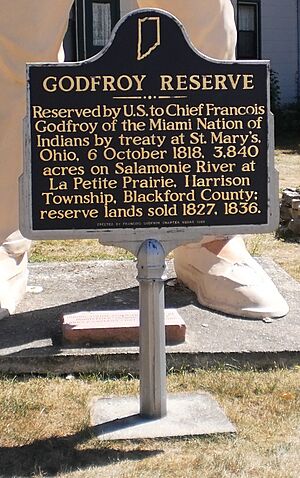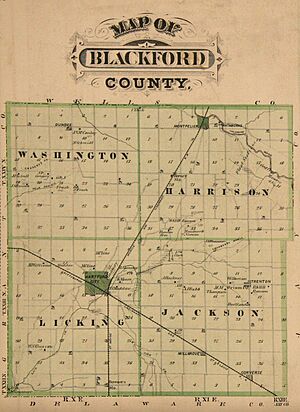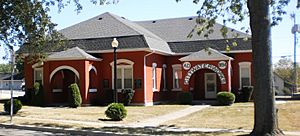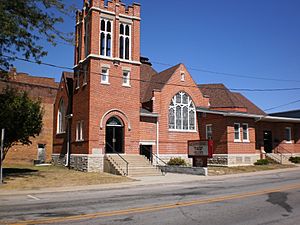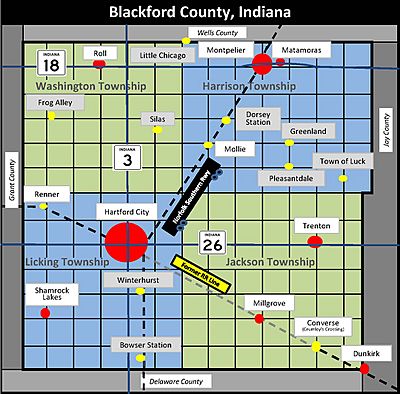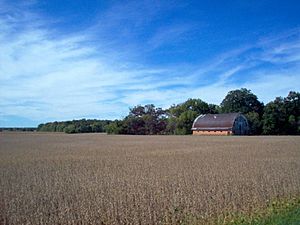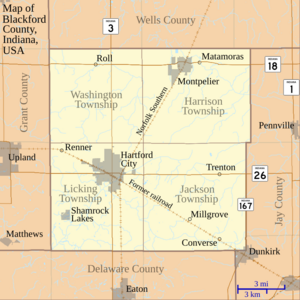Blackford County, Indiana facts for kids
Quick facts for kids
Blackford County
|
|
|---|---|

Blackford County Courthouse in Hartford City
|
|
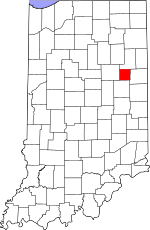
Location within the U.S. state of Indiana
|
|
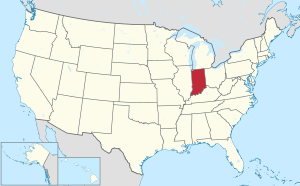 Indiana's location within the U.S. |
|
| Country | |
| State | |
| Founded | April 2, 1838 |
| Named for | Isaac Blackford |
| Seat | Hartford City |
| Largest city | Hartford City |
| Area | |
| • Total | 165.58 sq mi (428.9 km2) |
| • Land | 165.08 sq mi (427.6 km2) |
| • Water | 0.50 sq mi (1.3 km2) 0.30%% |
| Population
(2020)
|
|
| • Total | 12,112 |
| • Density | 77/sq mi (29.86/km2) |
| Time zone | UTC−5 (Eastern) |
| • Summer (DST) | UTC−4 (EDT) |
| Congressional districts | 3rd, 5th |
| Indiana county number 5 FIPS Code 009 |
|
Blackford County is a county in the east-central part of Indiana, a state in the United States. It was named after Judge Isaac Blackford, who was an important leader in Indiana's early government. The county was created in 1838.
Blackford County has four main areas called townships. Its main town, or county seat, is Hartford City. There are also two other cities and one small town. You can find many small communities and even some ghost towns here. Blackford County is one of the smallest counties in Indiana, covering about 165.58 square miles (428.8 square kilometers). In 2020, about 12,112 people lived here.
Even though there are no big interstate highways in Blackford County, several Indiana state roads cross through it. There are also two railroad lines that help connect the county to other places.
Long ago, before European-American settlers arrived in the 1830s, a small part of what is now Blackford County was a special area for Chief Francois Godfroy of the Miami tribe. The first settlers were mostly farmers. They built their homes near rivers where the land was good for growing crops. At first, much of the county was swampy. But as the land was cleared and drained, more areas became good for farming. Over the next 30 years, small towns started to grow. When railroads were built in the 1860s and 1870s, even more communities grew up around the train stops.
In the late 1880s, people found natural gas and oil in the county. This led to a huge economic boom called the Indiana Gas Boom. Many factories moved to the area because energy was cheap and they could use the railroads. This boom lasted about 15 years. Blackford County's population grew a lot during this time, reaching its highest point in 1900 with 17,213 people. New buildings were made of brick and stone instead of wood. Many of these buildings are still standing today. This includes the historic Montpelier Carnegie Library and many buildings in Hartford City's Courthouse Square Historic District.
Farming is still very important to Blackford County today. It became even more important after some large factories closed in the 1900s. In 2010, about 72 percent of the county's land was used for growing corn or soybeans. Other crops like wheat and hay are also grown.
Contents
History of Blackford County
For thousands of years, different groups of indigenous peoples lived in this area. The Miami and Delaware Indians (also called Lenape) were the first known permanent settlers in the Blackford County area. They lived on the Godfroy Reserve after a treaty in 1818. This reserve was in Harrison Township, east of Montpelier. Chief Francis Godfroy of the Miami tribe was given this land, but Delaware Indians also lived there. The Miami tribe was very powerful in the region. By 1839, Godfroy sold the reserve, and the Native Americans moved west.
Benjamin Reasoner was the first European-American to come to what would become Blackford County. He arrived on July 9, 1831, and was the first person to own land here. Reasoner and his sons built the county's first mill on their farm.
The land that is now Blackford County was first part of Jay County. Jay County was created in 1836. Two communities in Blackford County, Matamoras and Montpelier, were originally in Jay County. They are along the Salamonie River in the northeast part of Blackford County. John Blount started Matamoras in 1833. It is the oldest community in Blackford County. It also had the county's largest water mill, built around 1843.
Montpelier, west of Matamoras, was started in 1836 by settlers from Vermont. They named it after their old state capital. Montpelier was mapped out in 1837, making it the oldest planned community in the county.
Blackford County was officially created on February 15, 1838. It was supposed to start operating on April 2, 1838. However, it wasn't fully organized until January 29, 1839. That's when it officially became an independent county.
For the next two years, there was a debate about where the county seat (the main town for government) should be. The small community of Hartford was chosen many times, but people who wanted Montpelier to be the county seat disagreed. Hartford was in Licking Township, which had the most people. But Montpelier was the oldest planned community. After more laws were passed, Hartford was finally chosen. When people realized there was another town named Hartford in Indiana, Blackford County's Hartford was renamed Hartford City.
Over the next 25 years, the county grew slowly. Roads and railroads were planned, and swampy land was drained. The first railroad was planned in 1849 to connect Fort Wayne and Muncie. It would go through Montpelier and Hartford City. Construction started in the 1850s but wasn't finished until 1870. This made it the second railroad to operate in Blackford County.
The first railroad to actually run in Blackford County went east to west through the southern part of the county. This line was completed to Hartford City in 1867. It went through Dunkirk, Crumley's Crossing, and Hartford City. Crumley's Crossing was renamed Converse. Other towns like Millgrove and Renner also grew along this line. Part of this railroad line is now gone, with tracks removed between Converse and Hartford City.
Gas Boom in Blackford County
In 1886, natural gas was found in counties next to Blackford County. It was found in Eaton (south of Hartford City) and Portland (east of Hartford City). In early 1887, the Hartford City Gas & Oil Company was formed. They successfully drilled a natural gas well later that year. The Montpelier Gas & Oil Mining company also started in 1887.
Natural gas was found all over Blackford County. Oil was found mostly in Harrison Township, between Montpelier and Mollie. The county's first successful oil well started producing in 1890, south of Montpelier. Montpelier was even called "the very heart of the greatest natural gas and oil field in the world." By 1896, Blackford County had 18 natural gas companies.
In 1880, only 171 people in Blackford County worked in factories. The Indiana Gas Boom changed everything. Factories moved here to use the cheap natural gas and the railroads. By 1901, there were 21 factories in Blackford County, employing 1,346 people. The two biggest employers were glass factories: American Window Glass plant number 3 and Sneath Glass Company. Hartford City was especially popular for glass factories because of its cheap energy, two railroads, and skilled workers. In 1904, there were 10 glass factories listed in Hartford City.
The gas boom also made Blackford County look much nicer. Many important buildings were built during this time. This includes the current courthouse and other buildings around it in Hartford City. The city's water system was also built then. Other buildings include the Carnegie Library and the historic Presbyterian Church. Many buildings in Montpelier's Downtown Historic District were also built during the gas boom.
After the Gas Boom
The Indiana Gas Boom ended in the early 1900s. This slowed down the county's economy. Gas and oil workers left, some factories moved away, and other businesses had to cut back. Also, new machines made it easier to make window glass, so many skilled glass workers lost their jobs. By 1932, the biggest window glass factory in the county closed. Blackford County's population was highest in 1900 with 17,123 people. It has not reached that number again.
The end of the gas boom was especially hard for smaller towns. Losing just one business had a big impact. For example, Millgrove's main factory (a glass factory) closed. For other towns, like Mollie, losing gas and oil workers meant that local post offices and stores had much less business.
Cars and better highways also changed things. People started driving to bigger towns to shop because there were more choices. Cars also competed with passenger trains, so fewer people rode the railroads. Small towns that depended on train stations suffered. Passenger train service on one line stopped in 1931, and the last interurban train (a type of electric train) ran in 1941.
Even though many workers left, Montpelier's population eventually became stable, and Hartford City's grew. Some factories stayed because they didn't have better options. Hartford City's Sneath Glass Company stayed open until the 1950s. Hartford City leaders worked to bring new businesses, like Overhead Door (in 1923) and 3M (in 1955). Overhead Door was a major employer for over 60 years. It closed its Indiana factory in 2000. In 2011, Blackford County lost another 200 jobs when the Key Plastics plant in Hartford City closed.
Farming is still a very important part of the county's economy. More than 70 percent of Blackford County's land is used for soybean or corn fields. Other crops and farm animals are also raised. However, modern farming needs fewer workers, and family farms have become less common. Many small towns in the "Corn Belt", like those in Blackford County, continue to see their populations shrink.
Geography of Blackford County
Blackford County covers about 165.58 square miles (428.8 square kilometers). About 99.70% of this is land, and 0.30% is water. This makes it the fourth smallest county in Indiana. It is located in East Central Indiana, about 55 miles (89 kilometers) south of Fort Wayne and 78 miles (126 kilometers) northeast of Indianapolis.
Neighboring Counties
- Wells County (north)
- Jay County (east)
- Delaware County (south)
- Grant County (west)
The land in Blackford County was shaped by glaciers long ago. These glaciers left behind rich farmland. This land became very good for farming after it was cleared and drained. In the early 1900s, the Renner Stock Farm was famous for its high-quality cattle, hogs, and horses.
Rivers and Lakes
The county has some small streams and several man-made lakes. The Salamonie River flows from Jay County through the northeast corner of Blackford County. Big and Little Lick Creek flow west in the southern part of the county. Early settlers liked to live near Lick Creek and the Salamonie River because the land there was good for farming.
The county's lakes include Lake Blue Water in Harrison Township. Cain's Lake, Shamrock Lakes, and Lake Mohee are in Licking Township. Lake Placid is in Jackson Township. Lake Blue Water is a natural spring-fed lake that used to be a stone quarry. The Shamrock Lakes are a group of six lakes made between 1960 and 1965. The first lake was originally meant to provide water for a farmer's cattle.
Townships
- Harrison
- Jackson Township (named after President Andrew Jackson; created in 1839)
- Licking
- Washington Township (named after President George Washington; created in 1839)
Communities in Blackford County
Cities
- Hartford City (the county seat)
- Montpelier
- Dunkirk (most of this city is in nearby Jay County)
Towns
- Shamrock Lakes (became an official town in 1973)
Unincorporated Communities
These are smaller communities that are not officially cities or towns.
- Converse (used to be called Crumley's Crossing)
- Matamoras
- Millgrove
- Roll (used to be called Dundee)
- Trenton (its old post office was named Priam)
Most businesses in these communities have closed, but people still live in them. They are listed as populated places by the U.S. Geological Survey. Millgrove, Roll, and Trenton all had post offices in the past.
Old Settlements No Longer There
Blackford County once had over 10 communities that no longer exist. Sometimes, a church, farm, or single house is all that remains. Some of these old communities, like Bowser Station, Dorsey Station, Mollie, Silas, and Slocum, used to have post offices. Mollie's post office lasted until 1907.
People of Blackford County
| Historical population | |||
|---|---|---|---|
| Census | Pop. | %± | |
| 1840 | 1,226 | — | |
| 1850 | 2,860 | 133.3% | |
| 1860 | 4,122 | 44.1% | |
| 1870 | 6,272 | 52.2% | |
| 1880 | 8,020 | 27.9% | |
| 1890 | 10,461 | 30.4% | |
| 1900 | 17,213 | 64.5% | |
| 1910 | 15,820 | −8.1% | |
| 1920 | 14,084 | −11.0% | |
| 1930 | 13,617 | −3.3% | |
| 1940 | 13,783 | 1.2% | |
| 1950 | 14,026 | 1.8% | |
| 1960 | 14,792 | 5.5% | |
| 1970 | 15,888 | 7.4% | |
| 1980 | 15,570 | −2.0% | |
| 1990 | 14,067 | −9.7% | |
| 2000 | 14,048 | −0.1% | |
| 2010 | 12,766 | −9.1% | |
| 2020 | 12,112 | −5.1% | |
| 2023 (est.) | 11,893 | −6.8% | |
| U.S. Decennial Census 1790-1960 1900-1990 1990-2000 2010-2013 |
|||
In 2010, Blackford County had about 77 people per square mile. This is much lower than the average for Indiana, which was about 181 people per square mile. The county had 12,766 people living in 5,236 households. Most people (97.7 percent) were white. About 0.4 percent were black or African American.
The average household had 2.41 people, and the average family had 2.88 people. Families made up 68.1 percent of all households. Most of these families (75.5 percent) were a husband and wife living together. Children under 18 lived in 38.9 percent of family households. About 12.8 percent of all households were people aged 65 or older living alone.
The average age in Blackford County was 42.4 years. About 22.8 percent of the people were under 18. About 21.6 percent were 62 or older. For every 100 females, there were about 97 males.
In 2000, the average income for a household was $34,760. For a family, it was $41,758. About 6.0 percent of families and 8.7 percent of all people lived below the poverty line. This included 12.3 percent of those under 18. Many people in the county have German, American, Irish, or English backgrounds.
| Race | Number | Percent |
|---|---|---|
| White (Not Hispanic) | 11,278 | 93.1% |
| Black or African American (Not Hispanic) | 54 | 0.44% |
| Native American (Not Hispanic) | 38 | 0.3% |
| Asian (Not Hispanic) | 24 | 0.2% |
| Pacific Islander (Not Hispanic) | 0 | 0% |
| Other/Mixed (Not Hispanic) | 466 | 3.85% |
| Hispanic or Latino | 252 | 2.1% |
Climate and Weather in Blackford County
| Weather chart for Hartford City, Indiana | |||||||||||||||||||||||||||||||||||||||||||||||
|---|---|---|---|---|---|---|---|---|---|---|---|---|---|---|---|---|---|---|---|---|---|---|---|---|---|---|---|---|---|---|---|---|---|---|---|---|---|---|---|---|---|---|---|---|---|---|---|
| J | F | M | A | M | J | J | A | S | O | N | D | ||||||||||||||||||||||||||||||||||||
|
2
33
18
|
1.9
38
22
|
2.8
49
31
|
3.4
62
41
|
3.8
72
50
|
4.3
81
60
|
4.3
84
63
|
4.1
82
62
|
2.9
76
54
|
2.5
65
43
|
3.4
50
34
|
2.7
38
23
|
||||||||||||||||||||||||||||||||||||
| temperatures in °F precipitation totals in inches source: The Weather Channel |
|||||||||||||||||||||||||||||||||||||||||||||||
|
Metric conversion
|
|||||||||||||||||||||||||||||||||||||||||||||||
Blackford County has a typical Midwestern climate with four clear seasons. Winters are cold with some snow, and summers can be warm and humid. The average temperature in Hartford City ranges from about 18°F (-8°C) in January to 84°F (29°C) in July. The coldest temperature ever recorded was -26°F (-32°C) in January 1994. The hottest was 103°F (39°C) in June 1988. The county gets about 1.94 inches (4.9 cm) of rain in February and up to 4.33 inches (11.0 cm) in June.
March and April are known as tornado season in Indiana. On Palm Sunday, April 11, 1965, a very strong F4 tornado hit Blackford County. This was part of a huge tornado outbreak across the Midwest. F4 tornadoes have winds between 207 and 260 mph (333 to 418 km/h). This tornado crossed farmland east of Roll. No one died in Blackford County from this storm, but two people were killed in a nearby county. Blackford County has had at least five other tornadoes. The most recent ones were in Hartford City in 2002, but they were much weaker F1 tornadoes.
Blackford County also holds a record for hail. On April 9, 2001, hailstones 4.5 inches (11 cm) wide fell in Hartford City. These were the largest hailstones ever recorded in Indiana, tied with another city.
The biggest snowstorm recorded was the Great Blizzard of 1978, on January 26–27, 1978. The governor of Indiana declared a state of emergency. Low temperatures, strong winds, and deep snow made Hartford City almost empty. Schools and businesses closed. Wind gusts up to 45 mph (72 km/h) created snowdrifts 5 feet (1.5 meters) high, making travel nearly impossible. Snowmobiles were the only way to get around, and volunteers from Hartford City's Snowmobile Club helped people in emergencies.
Economy of Blackford County
Blackford County's economy relies on about 5,900 workers. In June 2013, the unemployment rate was 9.8 percent. There are industrial parks in Montpelier and Hartford City, and both cities have access to the Norfolk Southern railroad line. Over 30 different businesses are located in the county. The Blackford County School System is the largest employer, with schools in both Hartford City and Montpelier.
The 3M Company is currently the largest factory in the county. It has been in Hartford City since 1955. Another large employer with over 100 workers is Blackford County Community Hospital in Hartford City. Emhart Gripco is Montpelier's biggest employer, also with over 100 workers.
More than half of the jobs in the county are in four main areas: manufacturing (making things), government, retail trade (stores), and health care. Manufacturing is the largest, employing about 19 percent of the county's workers. Besides local businesses, many people also work in larger cities nearby, like Muncie and Marion.
Agriculture is very important to the county, even though farm workers make up only about 5 percent of the workforce. In 2007, the county had 250 farms covering 84,626 acres (34,247 hectares). This means four-fifths of Blackford County is farmland. Nearly 72,000 acres (29,000 hectares) are used for growing soybeans and corn. Wheat, hay, and oats are also grown. Farmers also raise animals, including over 24,000 hogs and pigs.
Transportation in Blackford County
There are no big interstate highways directly in Blackford County. However, Interstate 69 passes close to the county's western edge.
State Road 3 comes into the county from the south. It goes north through Hartford City and into Wells County. State Road 18 runs west to east through the northern part of the county, passing through Montpelier and Matamoras.
State Road 26 also runs from west to east. It enters from Grant County and crosses Hartford City, where it meets State Road 3. It then continues through Trenton into Jay County.
State Road 167 runs along the eastern border of the county for about 5 miles (8 kilometers). It goes north from Dunkirk and ends when it reaches State Road 26.
A Norfolk Southern Railway line comes into the county from the south. It runs near State Road 3 until it reaches Hartford City. Then it turns northeast and goes through Montpelier, continuing into Wells County. Norfolk Southern also owns the east-west railroad line in southern Blackford County. About 8 miles (13 kilometers) of this line, between Converse and Hartford City, were removed in the last decade. However, the line is still used north of State Road 26, between Hartford City and Upland.
Media in Blackford County
The first newspaper in Blackford County was The Hartford City Times, started in 1852. It was mostly for advertising. Another newspaper, The Blackford County News, started later in 1852. The Montpelier Examiner began in 1879, and it eventually became The Montpelier Herald.
The county's first daily newspaper, the Evening News, started in 1894 in Hartford City. It was later renamed Hartford City News. After its owner passed away, it was sold and combined with another newspaper, becoming the Hartford City News-Times. Today, it is called News-Times and is the only daily newspaper in Blackford County.
Blackford County can receive major television channels from Indianapolis and Fort Wayne. There are also some local TV stations in nearby cities like Muncie and Marion, but they might not cover the whole county. There are no AM radio stations based in Blackford County, but you can pick up signals from nearby cities. Several FM radio stations are available, including some in Hartford City and Montpelier. Internet access is available in Hartford City, Montpelier, and some rural areas of the county.
Notable People from Blackford County
Astronaut Kevin A. Ford lived in Montpelier, Indiana, for several years. He graduated from Blackford High School in 1978. Born in 1960, he earned four academic degrees. Ford retired as a colonel from the United States Air Force in 2008. He was the pilot for the Space Shuttle Discovery in 2009 and has spent over 332 hours in outer space. In 2012, Ford returned to the International Space Station on a Russian spacecraft.
Radio DJ Larry Monroe was born in Hartford City, Indiana, in 1942. He graduated from Hartford City High School in 1960. From 1981 until his death in 2014, he was a very popular radio personality in Austin, Texas. His shows are still played on the radio today.
Clarence G. Johnson lived in Hartford City from 1923 until he passed away in 1935. He was the first president of Overhead Door Corporation. He was a pioneer in developing garage doors and held many patents. One of his most famous inventions was the first electric opener for garage doors. Johnson's Overhead Door Corporation was a major employer in Blackford County for over 60 years, employing as many as 515 people.
Former Indiana governor Maurice Clifford Townsend was born in Blackford County's Licking Township in 1884. He worked as a school superintendent in Blackford and Grant counties. He also represented the Blackford-Grant District in the Indiana General Assembly. He was elected as Indiana's lieutenant governor in 1932. In 1936, he became governor and served one four-year term. After his time as governor, Townsend worked for President Franklin D. Roosevelt on agriculture projects. A memorable thing he did was to make school buses yellow for safety and easy identification. This idea spread across the country!
Golfer Erika Wicoff, from Hartford City, is one of the most celebrated female athletes from Indiana University. She won the Big Ten Player of the Year award three times. She was also the Big Ten women's golf champion in 1994, 1995, and 1996. Later, she played in the Ladies Professional Golf Association. Wicoff was added to the Indiana Athletics Hall of Fame in 2006.
Images for kids
-
Blackford County Courthouse in Hartford City
See also
 In Spanish: Condado de Blackford para niños
In Spanish: Condado de Blackford para niños


